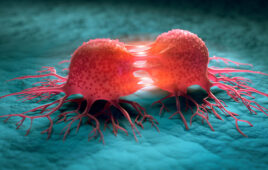Pharmaceutical companies give their all to develop pediatric vaccines against rotavirus infection, Dengue Fever, and more.
 A child receives the oral, rotavirus vaccine RotaTeq. (Source: Merck) |
The advent of childhood vaccination has probably saved more lives than all of non-vaccine pharmaceuticals ever developed, combined. And although such preventative measures have been part of standard medical care in developed nations for decades, they have only recently become more accessible in developing nations.
Case-in-point, rotavirus infection, the most common cause of viral gastroenteritis in children, causes tremendous morbidity worldwide. “Every child around the world is infected with rotavirus by the time they are three to five years of age, regardless of who they are, where they live, or their socioeconomic status. Everyone is infected,” says Leonard Friedland, MD, executive director and head, Clinical and Medical Affairs, Vaccines, North America, GlaxoSmithKline (GSK), King of Prussia, Pa. Rotavirus infection is transmitted via the fecal-oral route. Consequently, it is common in nurseries and day care centers where, in the process of changing diapers, a caregiver can pass infectious stool from child to child.
The etiology of viral gastroenteritis in infants was discovered in the 1970s through the work of many physicians and researchers; the culprit was eventually identified as rotavirus. One now classic study conducted by a physician named Raoul Velasquez, where he collected stool samples from 200 newborns every week for two years, examined the natural history of the virus. “In this study, [Velasquez] found that everyone was infected with rotavirus over the first two years of life. But interestingly, some children would get second, third, fourth, and fifth infections. However, when they got their subsequent infections, they were not as sick from the disease,” says Friedland. The evidence for this phenomenon came when Velasquez was able to recover rotavirus in the stool of children who had recovered from a previous rotavirus infection but who were not sick from the current one. “And when they started to understand that there are different types of rotavirus, they discovered that not only does the child develop their own immunity to protect themselves from getting subsequent, severe infections, but they are also protected regardless of what type of virus they had the first time around or the second time,” explains Friedland. The adjective “severe” implies that the rotavirus infection requires hospitalization and/or intravenous rehydration.
|
Symptoms of rotavirus infection include fever, diarrhea, and vomiting, which can cause mortality in parts of the developing world where access to intravenous fluids for rehydration may be unavailable. Even for children who do not die and don’t need IV rehydration, there is still plenty of morbidity from rotavirus infection. Rotavirus-infected children still get sick; their parents miss work, producing an economic burden; and doctor’s offices are filled with rotavirus-infected children, taxing the health care system. “The reason to prevent [rotavirus infection] is that the treatment for the disease is basically limited to replacing fluids and keeping the child well-nourished. There is no antibiotic or antiviral to treat the disease to make it go away faster.”
Rotavirus vaccines
The first company to develop a vaccine to prevent rotavirus infection in children was Wyeth Pharmaceuticals. Work on what would become RotaShield began at the US National Institutes of Health in the early 1980s; this work showed proof-of-concept. When Wyeth became involved in the development of this rotavirus vaccine in the early 1990s, the company formulated the vaccine and conducted the clinical trials required for licensure.
“RotaShield was a ‘Jennerian’ vaccine. It used an animal virus, which didn’t cause disease in humans, to induce an immune response that would protect against the disease in babies—similar to the smallpox vaccine that Edward Jenner developed based on the cowpox virus. RotaShield used a monkey virus backbone,” says Peter Paradiso, PhD, vice president, Scientific Affairs, Wyeth Vaccines, Collegeville, Pa. “The key challenges were to develop a vaccine that addressed all four strains known (at the time) to cause rotavirus, to create an orally-administered vaccine, and to prevent severe disease. Wyeth overcame all of these challenges.”
RotaShield was licensed in the US in the late 1990s, but the FDA pulled the vaccine when it was found to be causally-associated with intussusception—a rare form of intestinal blockage. When RotaShield was pulled from the US market, “this created a moral dilemma and no [other] governments would recommend the licensure of RotaShield or the use of it in their countries because it was withdrawn from the US,” says Friedland. “And so this was a major setback for public health because a vaccine, which was proven to be very effective in preventing rotavirus, was now unavailable.”
The withdrawal of RotaShield led the pharmaceutical industry to question whether or not every rotavirus vaccine would be associated with intussusception. “[Intussusception] occurs in about three to five in every 10,000 infants in the first year of life. And those who know how to quickly do statistics could say if you need to do a clinical trial to demonstrate that a new vaccine does not produce intussusception … you’re going to need 60,000 to 70,000 children in a clinical trial to show that a new vaccine does not produce intussusception.”
Despite the fact that conducting such a clinical trial would be a tremendous undertaking and that failure was a possibility, Merck and GSK went on to develop separate rotavirus vaccines anyway. Starting in 1997, both Merck and GSK began conducting clinical trials to test the efficacy and safety of their respective rotavirus vaccines, Rotarix and RotaTeq, on over 60,000 infants. “The [GSK] trials were performed in Latin America because severe morbidity and mortality associated with rotavirus affects children mostly from low- and middle-income countries. GSK launched its vaccine in January 2005 in Latin America and then in parts of Africa, Asia, Europe, Canada, and then lastly, in April 2008, in the US,” says Friedland, who adds that GSK’s decision to license the vaccine last in the US was based on a decision to first license the vaccine in parts of the world where rotavirus morbidity and mortality is greatest.
Merck licensed the vaccine that eventually became RotaTeq from the Children’s Hospital of Philadelphia and the Wistar Institute in 1991. The prelicensure clinical trials for this vaccine were conducted from the mid-1990s through 2005. “As you probably know, these trials for RotaTeq were one of the largest ever conducted by industry. The trial that was called REST (which is an acronym for the Rotavirus Efficacy and Safety Trial) involved approximately 70,000 infants in 11 countries was conducted from 2001-2005,” says Michelle Goveia, MD, MPH, medical director, Pediatric Vaccines, Medical Affairs and Policy, Merck Vaccines and Infectious Diseases, West Point, Pa. Two other Phase 3 trials were conducted for licensure: one trial looked at the safety and efficacy of the vaccine at the end of its shelf life, and the other satisfied a regulatory requirement by looking at the manufacturing consistency of the vaccine.
Shortly following licensure in the US on February 3, 2006, the vaccine was accepted into the US children’s routine vaccination schedule by the Advisory Committee on Immunization Practices (ACIP) on February 21, 2006. RotaTeq is a human bovine reassortant, oral vaccine that is pentavalent—containing the five strains of rotavirus found in 90% of all US rotavirus infections.
In summary, the storied history of the development of rotavirus vaccine may have had a rocky beginning, but it has had a strong finish. And fortunately for children worldwide, there is now a safe and efficacious vaccine available.
This article was published in Drug Discovery & Development magazine: Vol. 10, No. 9, September, 2008, pp. 36-38.
|
Filed Under: Drug Discovery




